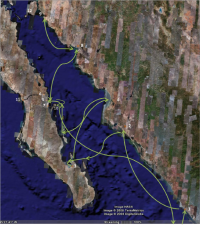Kino - California Founder
CORRESPONDING SUBJECT PAGE LINKS: To receive a full account of Kino’s work in California, click on the links below to the main corresponding subject pages. To view Kino’s explorations and the interesting account of Kino sailing along the Pacific Coast to Acapulco to protect a Manila Galleon from pirate attack, click Explorer Baja and Pacific Coast page. To view Kino's decade long advocacy after leaving Baja and his supplying its precarious restarted missions from the mainland, click California Builder page.
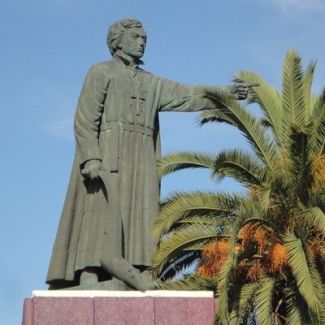
Largest Monumental Kino Statue
Tijuana, Baja California
Why Such Great Interest In Baja California?
Ernest J. Burrus
Why Such Great Interest In Baja California? The question can be answered in a few words. The extraordinary interest derived not so much from what Baja California was - an extensive and unproductive peninsula, almost completely uninhabited and uninhabitable - as for what it was believed to be - a land rich in pearls and precious metals, bordering on the Straits of Anian, part of the Northwest Passage, linking the Atlantic with the Pacific, shortening by thousands of miles the distance between Europe and the New World as well as with the Far East.
Spain regarded the California coast as capable of furnishing ports of call for her ships sailing from the Philippines and the East to New Spain. The long voyage, often demanding six or seven months, regularly exhausted the water supply and all fresh food. The Californias could, and from the 18th century on actually did, replenish both. Most of the crew and passengers were in the last stages of scurvy and beriberi by the time they reached the continent and could not possibly hold on to life to reach Acapulco, their final destination. Their only hope and cure was to go ashore, eat fresh food, especially fruit, and rest for some days.
English and Dutch ships had often put into California harbors, bays and other inlets, particularly at the southern tip of the peninsula, staying there at will. They plundered Spanish shipping along the West Coast as it attempted to ply the Pacific. If enemy vessels could reach New Spain by such a direct and short passageway as the Straits of Anian, the heartland with all its mineral and other riches was dangerously exposed to their depredations. The plundering by British, Dutch and French ships of coastal cities and of shipping on the high seas left no doubt about their sinister intentions. These were made all the more frightening by the recent exposure of the attempts of Peñalosa, the ex-governor of New Mexico, traitorously to reveal the secrets of Spain's fortifications. That such treason could also be translated into action was evident from the earlier loss of Jamaica effected by the English ex-Dominican priest, Thomas Gage.
If Baja California really bordered on a part of the Anian Straits, as most cartographers held, it was imperative for Spain to deny access to the unique waterway by occupying the peninsula and going over to the offensive by taking possession of it and profiting by its geographic position.
It was in such a context that Spain regarded Baja California as an important outpost, a key bulwark, not to be lost to the enemy. On this matter there was no doubt or vacillation. Given the unfavorable state of the exchequer, it did not send the necessary military force to assure the security of the peninsula. Nor did it support the Jesuit missionaries sufficiently to enable them to move northward into Upper (modern) California. It took the Russian threat in the late 1760s to persuade Spain to take this decisive step.
On certain policies, the modern student finds a puzzling ambiguity on the part of the Spanish government and even of the Jesuit Order. Not a one of the three classic institutions - town, mission and military fort - used by the Spaniards to assert their presence and guarantee their frontiers as inviolate, was really encouraged as it should have been. For many years, the Spanish officials, even the kings and viceroys, acted as though they did not care whether the missions and the entire enterprise succeeded or not. Only the superhuman efforts and heroism of the missionaries kept the enterprise from utter collapse.
Spanish financial support consisted mainly in empty promises. As we have seen, the entry into Baja California began without royal approval or support. When the entry and foothold were seen to be successful and officials considered them as advantageous, a small annual subsidy was promised for continued progress. Unfortunately, this was a promise more honored in the breach than in the keeping. During some seventy years of Jesuit activity, the actual royal contribution never amounted to more than a small percentage of the expenditures. For most of us moderns who do not have the firm faith of the missionaries nor their vision of time and eternity, it is hard to understand why educated men, accustomed to the comforts and pleasures of Europe, would sacrifice all to work in such harsh surroundings and trying conditions.
Some of the Jesuits - Kino was the first - had urged the establishment of Spanish towns to secure firm possession of the land and to help in its defense. Other Jesuits feared the evil effects of Spanish presence on the naive and primitive natives. Enemies of the Order - Visitor General José de Gálvez, in particular - interpreted this attitude of some missionaries as conclusive evidence of the desire of the Society of Jesus to enjoy undisturbed the monopoly of unlimited riches.
Jesuit promoters of the enterprise, anxious to secure Spanish interest in the peninsula, pointed out the potential wealth of rich pearl beds. But other Jesuits - especially those on the scene opposed the exploitation of such riches for fear that the natives would be abused and withdrawn from necessary religious instruction. ...
Ernest J. Burrus
Why Such Great Interest In Baja California?
Introduction
Jesuit Relations, Baja California, 1716 -1762
Baja California Travels Series, Volume 47, 1984
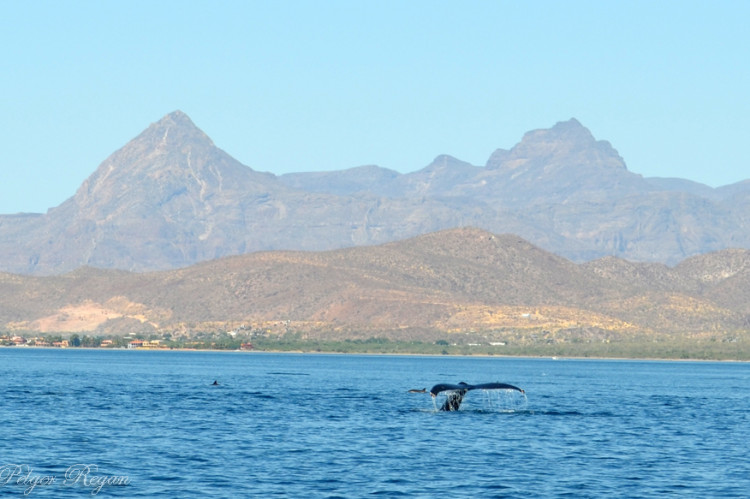
Gulf of California and Sierra Gigante near San Bruno
"Prelude To Permanency"
Peter Masten Dunne
Lower California received various visits from the white man long before any permanent settlement had been made upon its rocky coasts. The vision and ambition of Hernán Cortés, ever reaching out to other worlds, sent an expedition into the gulf eleven years after his conquest of Mexico, but the men did not see the peninsula and touched only upon the opposite coast. The white man first gazed upon this barren land the following year (1533) when Cortés, determined to "pierce the mysteries of the North," sent out a second group. When the crew mutinied and murdered its commander, Fortún Jiménez took charge and succeeded in setting his men upon the shores of the bay of La Paz. Indians set upon the stragglers, murdering Jiménez and twenty of his men the rest escaped to carry to the mainland stories of wealth -- not of gold this time but of pearls.
Such reports stimulated the energies of the great Conquistador, and Cortés resolved to go himself to these coasts and investigate. Early in May, 1535, three ships carrying Cortés and the men who had volunteered for the adventure entered the same bay of La Paz. Another enemy now attacked the explorers: hunger. As supplies ran out, two ships were sent to the mainland. One was eventually wrecked, and when Cortés himself set out to bring in food he returned to find that twenty-three of the men had died of starvation. He eventually gave up the game and never returned. One was eventually wrecked, and when Cortés himself set out to bring in food he returned to find that twenty-three of the men had died of starvation. He eventually gave up the game and never returned.
But what came to be called California, and subsequently Baja or Lower California, had been discovered. Soon after these early exploits those who wrote about them began to call the country California.
There were other expeditions. … The hunt for pearls used up the chief energies of the men participating in these expeditions, the cactus-ridden land would not yield a sustenance, the settlements had to be abandoned. So for almost a century and a half storms and pirates and especially the barren coast broke every effort to colonize Lower California.
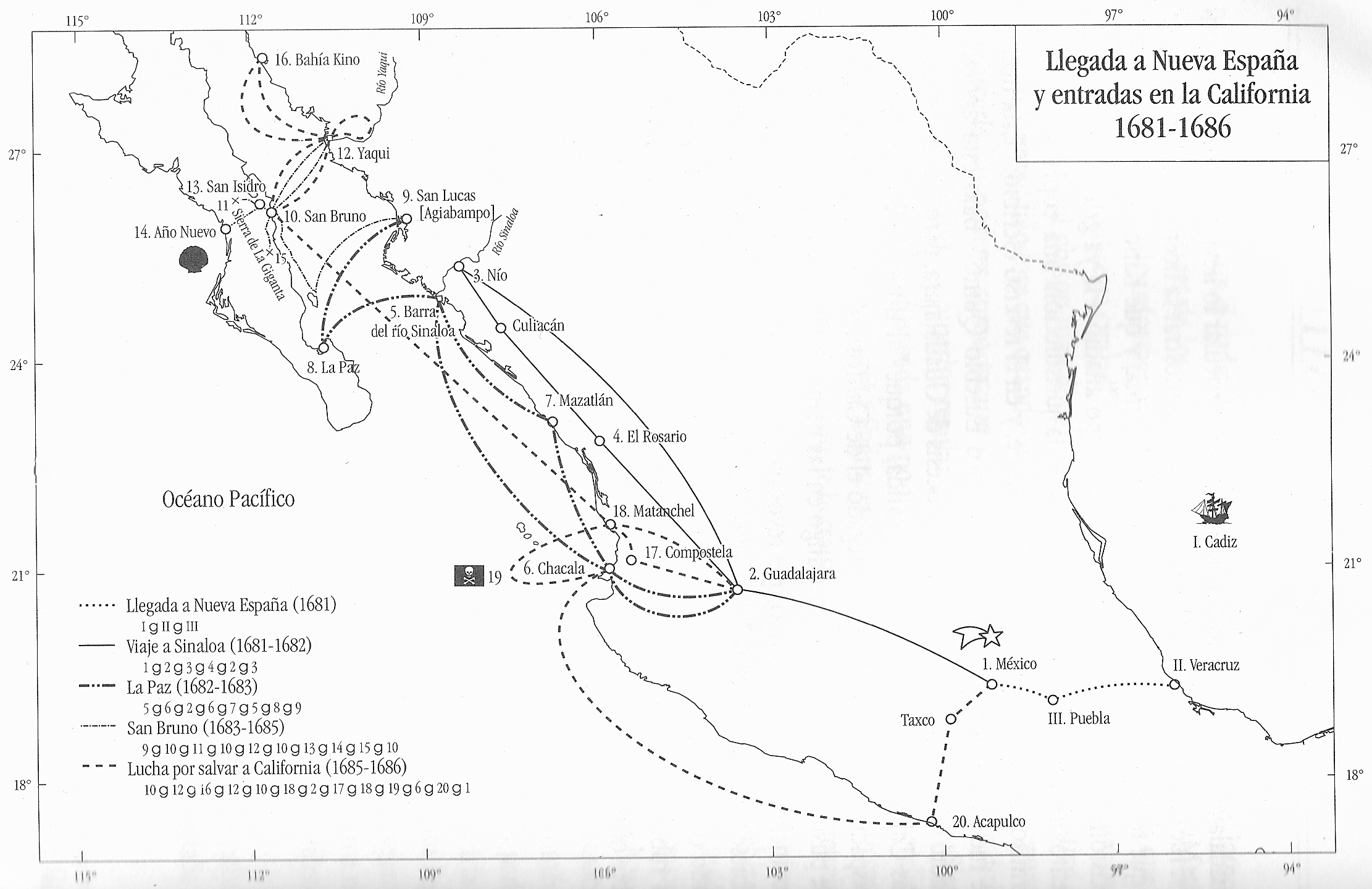
Map of Kino's Mexican Mainland, California and Pacific Ocean Trips Before Kino's Assignment to the Pimería Alta
To View Legend, click Llegada Map Legend document (pdf)
Then, in 1681, there arrived in Mexico the north Italian, the vigorous and energetic Eusebio Francisco Kino, who as Jesuit missionary, explorer, and province builder was destined to make history both in Lower California and along the mainland's western slope north into what is today the state of Arizona.
Private hands had been too intent upon the pearl fisheries to permit of their carrying through a successful colonization. But for strategic purposes the government wanted to colonize and to hold Lower California. Every year returning from Manila by the northern route there came swinging down the coast the Spanish galleon laden with its precious wares from the East -- silks and porcelains from China, savory spices from the Moluccas and the Philippines, beeswax and taffeta from Manila. Ports of call were necessary along the coast or near Cape San Lucas at the tip of the peninsula, for the ships would have to be overhauled and the men, many always sick with scurvy, would need rest, fresh water, and the juices of the maguey and prickly pear. Spain needed to have and to hold this crooked peninsula. The need became urgent when the foreign freebooter appeared in these waters. Sir Francis Drake had sailed up the outer coast in 1579. Eight years later Thomas Cavendish lay in wait for the Manila galleon, robbed it of the precious cargo, burned the ship, and set sail for England west across the Pacific, rounding the globe as Drake [29] before him. After the English came the Dutch to prowl about these waters.
Since private expeditions, therefore, had so often fallen short of permanent colonization the government was forced to undertake the task and at its own expense. The new policy led to the Atondo expedition and the coming of Kino to Lower California.
Don Isidro Atondo y Antillón had been both seaman and soldier. At the time that Father Kino arrived in Mexico Atondo was governor of Sinaloa. "He knew a jib from a topsail and a mortar from a pedrero." It was agreed between himself and Viceroy Rivera, who was also archbishop of Mexico, that he should lead an expedition across the gulf at government expense, pacify and Christianize the Indians, explore the interior, build forts and missions, and otherwise institute a permanent settlement if suitable lands could be found for its support. The project was entered into with all seriousness and from two to five years were to be spent in its preparation: the building of ships, collection of supplies, designation of missionaries, enrollment of a force of men of suitable character, for the Indians were not this time to be alienated by rough treatment. A contract to this effect was signed by Atondo in 1678 and approved by the king in Spain the following year. ….
Kino had long harbored ambitions for the Chinese missions, but was later designated for New Spain, and he became the first missionary and chief promoter of the permanent missions of Lower California. Arrived in Vera Cruz in May, 1681, after a voyage of ninety-six days across the Atlantic, Kino was in Mexico City in early July. He was soon busy writing a book on the comet which had appeared the previous year. He left the capital for the west coast in mid-October and arrived in Nío in March, 1682. The following October the two newly built ships slipped down the river from Nío and turned south to Chacala to pick up the supplies which had been assembled there. Finally, on January 17, 1683, at midnight, the expedition sailed.
The ships headed north at first, touched at Mazatlan and the mouth of the Río Sinaloa, and then put out across the gulf. Travel up the mainland coast was slow. Then, attempting to cross, they were held five days within sight of land at Sinaloa, and it was only on March 25 that from the sea they glimpsed the coasts of the peninsula. On April 1 Atondo reached the palm-fringed bay of La Paz, anchored there and went ashore and chose a site for the settlement and mission. ….
A little chapel and a fort were thrown together and explorations into the interior were begun. There were some contacts with the Indians, with the Coras, southeast, and with the Guaicuros, southwest. Toward the end of April one of the ships, the Capitana, was sent back to the mainland for supplies. The two fathers were trying to pick up the languages, Goñi that of the Coras, Kino that of the Guaicuros.
The Indians began to come about the camp and soon began, also, to become too familiar, to pilfer, and even to shoot a soldier with a dart, which did not, however, even draw blood. The mulatto drummer boy had disappeared, and the Spaniards thought he had been killed by the Indians. Atondo considered the natives should be taught a lesson. He did indeed teach them a lesson, that of his own rashness and cruelty to the undoing of this La Paz settlement. Early in July sixteen Guaicuro warriors came to camp, making signs of peace. Atondo ordered them to be given pozole, or porridge of corn meal. While they were squatted on the ground thus feasting, a cannon ball was fired at them, killing three and wounding others.
The rash act spelled the end of the La Paz venture. The soldiers were now panic-stricken with fear that a horde of Indians would rush in and slaughter them in revenge. Besides, the ship, the Capitana, had not returned and supplies had practically run out. It was decided to abandon the settlement. The Spaniards pulled up stakes and sailed away July 14. ….
The expedition set out a second time to cross the gulf to California, September 29 of that same year of 1683, and after some adventure from storms the good ship Almiranta and the Capitana touched at the "Río Grande," October 6, Feast of San Bruno, which gave a name to the new settlement. The report of Captain Guzman was now verified: the Indians were indeed friendly and respectful and were soon coming around in goodly numbers. Although the "Río Grande" was dry, water could be had by digging holes in its sandy bed. A site for settlement was chosen on the mesa above the beach, and supplies were landed: fifteen horses and mules which Atondo had brought with him, corn, wheat and other food. Brush was cleared away, and the construction of a fort, a church, and dwellings was begun.
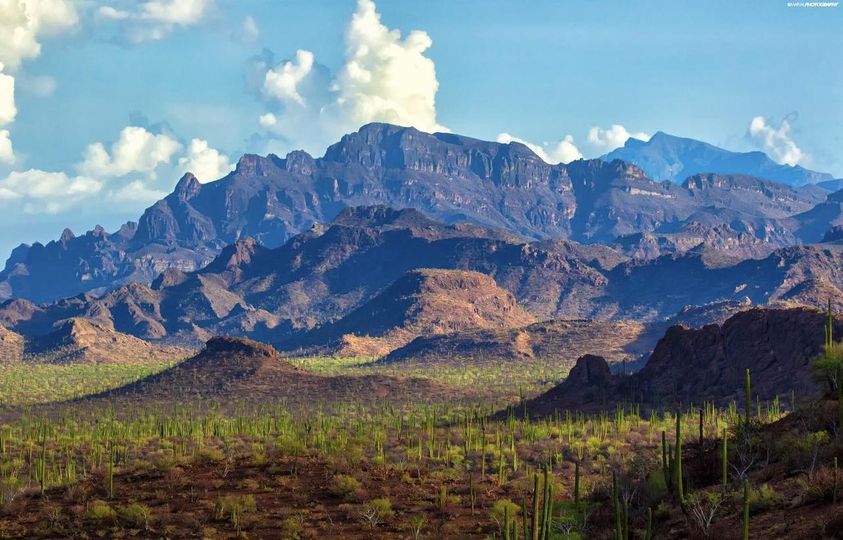
Sierra de La Giganta Near Gulf Coast
With the food problem settled, Atondo and Kino could move about with some security and satisfaction and explore the land. To the west of them the Sierra de La Giganta lifted against the sky a barrier of rocky ledges and craggy pinnacles. The Indians spoke of giants on the other side. The two leaders wanted to gaze upon the western spurs and slopes and perhaps explore therein. A party started northwest up the valley of the "Rio Grande" and then turned boldly west to try to scale the precipitous sierra. Scouts sent ahead returned to report that these rocky flanks could not be attempted by the animals and were difficult even for the men. The following day a divide was sought but not found. The men decided then to scramble to the summit "on all fours," leaving their mounts behind them. In spots munitions and provisions had to be hauled up by ropes, and even Atondo and some others had thus to be aided. If Atondo was as fat as he was pompous we can imagine some amusement at the sight of his dangling in mid-air at the end of a rope.
The summit was finally gained and the prospect gave its reward; rough mesas stretched out before them on the other side. The party descended from the crest and explored a few leagues down along lower country, Indians scurrying away with fright at their approach. A whole day had passed, and Atondo was played out. It was decided that on the morrow he should rest with some of his men; Kino and others would go farther west, taking food for two days, the going and the return. Kino contacted some Indians, gave them little presents, and seemed to have gained their good will. Early on this day's march the men came upon a large village. They had gone thirty miles; next day they returned to where Atondo had camped in their absence. Back at San Bruno, Atondo and Kino wrote reports on their experiences. Kino's bore the date December 21, 1683, the day on which he completed a map of the region he had just explored. Soon the good ship Capitana was bearing these documents across the gulf to the mainland.
The energetic Black Robe did not seem able to rest a single day. For, on that same date, December 21, he was on the trail again, northwest, looking for a pass in the sierra through which the pack animals could be taken. He was successful. He forged out into the plains to the west, reached another large village, and was shown by the Indians a shorter return by another pass to the south. On Christmas Eve the party was back in San Bruno. Their arrival was celebrated by "feasting and music, lights, and dancing in the church." They had midnight Mass, too, with two Masses following. Those were happy hours for Kino, those of Christmas Eve and the hours during which the Masses were being offered. Apart from the spiritual significance (his first Christmas spent in California) he had achieved a notable success -- had discovered two different passes through the crests of the Giantess leading to the west coast. ...
The spring and summer of 1684 passed somewhat uneventfully, but not monotonously, at San Bruno. ….
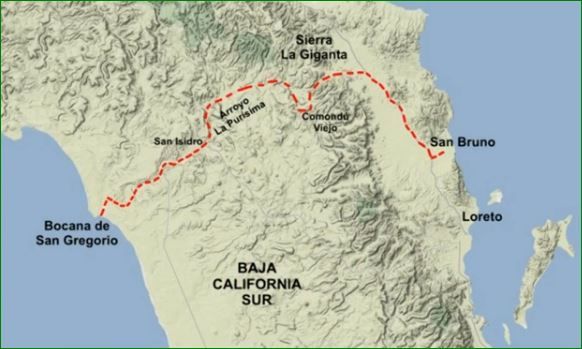
First European Expedition Across Baja
After the return of the Almiranta in December [1684], a journey long projected by Atondo and Kino got under way. It was a trek to the west coast of the peninsula, the journey to the South Sea. The start was made on December 14. The expedition had to surmount almost incredible difficulties.
The steep and narrow passes of the Sierra La Giganta had to be threaded by man and beast, Indian guide and plodding pack animal. Still another range had to be negotiated. Then the road led down the Río Santo Tomás which, after a few miles, cut straight through a gigantic bastion of rock the walls of which rose sometimes a thousand feet above the bed of the stream. It was two days before Christmas when the expedition saw the opening of the gorge. Could it get through? Scouts reported the passage impassable for horses. On Christmas Eve the party rested while Atondo made a difficult decision; it was to go on, so the perilous passage was begun on Christmas morning. Horses slipped and fell, packs loosened and rolled into the stream, and the men barely escaped drowning.
Five miles of this agony and they emerged into open country. The way now lay level to the sea and within a few days Atondo and Kino and their bedraggled little band reached the shores of the Pacific Ocean. They were the first white men to cross the peninsula of California at any part and to gaze at the sea. It was a historic event which they no doubt realized and "each man felt like a Balboa." The date was December 30, 1684. They explored an estuary formed by the Río Santo Tomás to the south and on the last day of the year Kino and Atondo journeyed up the coast for six leagues and returned to camp to see the old year out and the new year in. Appropriately they called the harbor Año Nuevo.
Kino had seen some Indians. They were as timid and fearful as frightened deer, but the padre was able gradually to attract them and to give them presents: "hawks-bells, scissors, knives, handkerchiefs, earrings, fillets, bracelets, and moccasins," as Kino narrated. The missionary saw more than Indians. He admired "shells of rare and beautiful luster, and of all colors of the rainbow," and especially some large, blue abalone shells. He never forgot these, and years later when he saw the natives of the mainland using the same kind of blue shells, he began to suspect that California (which he had called the largest island in the world) was not an island at all, for the Indians never crossed the gulf and these shells were not found on the mainland coast.
The expedition's work was now completed and the party could return. The men reached San Bruno on the east coast January 13. They had accomplished much; they had made history; but their hopes of watered, fertile lands were dashed. They found that the country to the west over the peninsula's backbone was also desert.
About this time misfortune came to the colony. The Almiranta had left for Matanchel on December 14, the day of the start for the west coast. Weeks and months passed while the little colony stood marooned and facing hunger. No sail was sighted until the middle of March when the Balandra, having finally made it, appeared off San Bruno. Later Guzman came in with the Capitana. He found conditions bad. There had been but one light shower in eighteen months, which meant that there was little potable water and what with too much salted food scurvy broke out among the men. Some became paralyzed and were on the point of death. The native women and domestics were themselves prostrate.
Atondo called a muster roll. Only fifteen men appeared; thirty-nine were too ill to show up. Surgeon Castro said he had tried every known remedy without avail. The men clamored to return to the mainland. Atondo after a council made his decision: he would depart for the time being, have the sick men carried to Rio Yaqui, and he would hunt for pearls southward along the coast. So it was that California was abandoned for a time against the will and the strong protestations of Kino.
The idea of a return to California was not given up at all. Neither Kino, nor Atondo, nor officials of New Spain from the viceroy down were willing to strike California from their agenda. When Kino, after his visit to the Seri Indians and after helping Atondo convoy a Manila galleon to Acapulco, finally got back to the capital he went to visit the viceroy. The Black Robe's inborn optimism was caught by the Marques de la Laguna who bade both padre and Commander Atondo give him a written report. Most of what Kino did now, it seems, was to write letters and reports, urging California. Atondo did much the same.
The royal treasurer, Don Pedro de la Bastida, was strongly in favor of another attempt at the dry peninsula. So was the viceregal council. But these ardent hopes were destined to be dashed. The Jesuit provincial would not undertake to finance another expedition. The royal treasurer, Bastida, then recommended an annual appropriation from the government of 30,000 pesos for the support of four missionaries and twenty-five soldiers with eight Yaqui families as laborers. This was approved by the viceroy and awaited only the consent of the king. ….
A French ship had gone to the bottom of the bay of Cadiz and an indemnity was demanded. And even in New Spain trouble was stirring in Tarahumara. So, not even thirty of the eighty thousand could be spared for California. The money was shunted off to other places, among them the pockets of the French king. For the nonce the California game was up and Kino would have to wait for more propitious times.
Dr. Peter Masten Dunne, S.J.
"Black Robes in Lower California"
Excerpts from Chapter 2 "Prelude To Permanency"
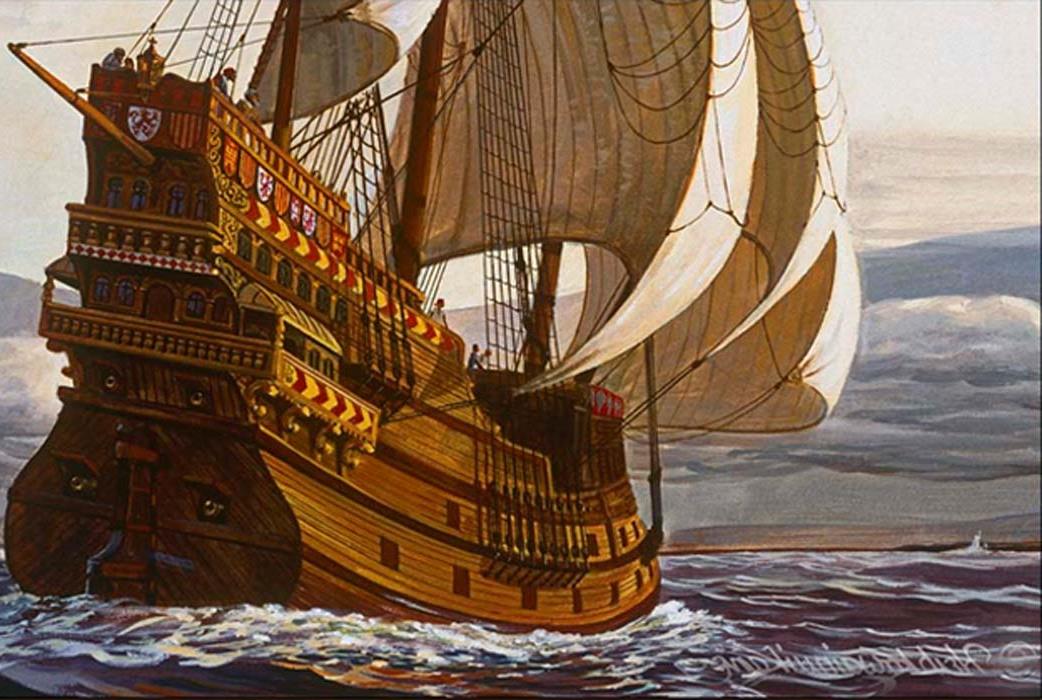
Manila Galleon Approaching California Coast
Baja Departure and Kino's Vision
Pirate Threat to the Manila Galleon Prevents Kino's Return
Ernest J. Burrus, S.J.
Obviously, the little [Baja] colony could not live on greater geographical knowledge and on hopes for a brighter future. They had to find more suitable and productive localities, if they were to survive. ...
The discouraging past, the uncertain present, and the unpromising future, all conspired to dismay the bravest soldiers and even Atondo himself. Only Kino pleaded to hold out a little longer or at least to try another locality in the vicinity. He volunteered to explore for an appropriate site. He pleaded that they should not completely abandon the area where he had already instructed so many natives. His plea was in vain. The decision had been made to cross over to the Mexican mainland, replenish the depleted supplies from the Jesuit missions in the Yaqui valley, and then recross the Gulf in order to explore the peninsula farther to the north. ....
Although probably no one said so, Lower California had been abandoned by early May of 1685. It was not destined to be settled permanently until October, 1697, when Father Juan Maria Salvatierra would sail into the bay of San Dionisio and establish the mission and town of Nuestra Señora de Loreto.
Kino now sailed with Atondo to Matanchel, near Chacala, from which the little fleet had weighed anchor so proudly and confidently more than two years previously. From Matanchel Kino hurried overland to Guadalajara, and there poured out his grief to Bishop Garabito because of the abandonment of Lower California.
He was requested by civil and ecclesiastical authorities to draw up a report. In doing so, he did not waste his time blaming Atondo or anyone else. He did review the past, but only to point out what should be corrected; his emphasis, however, was on the future: how the California enterprise could be effectively and successfully re-activated. The report: was his first comprehensive "vision of the future ". ...
Missions and forts, Christian Indians and soldiers, violence and the Gospel, did not mix well. Ranches and farms would raise the economic and social status of the natives and make the missions independent of state aid and control; they would help to win over and hold the Indian population. Smaller and more maneuverable boats, supplemented by a feasible land route, could provision Lower California far better and more economically than the bulky and unwieldy ships engaged in hauling supplies from distant ports. He would make friendly natives his best allies and most effective defenders against hostile intruders. He would even show enemy tribes the advantages of a better and more secure way of living. He would explore more fully and accurately than any of his predecessors; above all, in the areas visited, he would leave devoted friends and allies.
Copies of Kino's preliminary 1685 plan went to Bishop Garabito, the Mexican Viceroy, Jesuit Superiors, and friends in Europe, in particular to the Duchess of Aveiro with the plea that she intercede with the highest Spanish officials in behalf of California.
Viceroy Paredes was convinced by Kino's report. He ordered the immediate re-activation of the Lower California enterprise. Missionaries and twenty men were to be taken back to San Bruno.
Kino was overjoyed at the favorable decision. He returned to Matanchel from Guadalajara, ready to join the new California expedition. The flotilla was riding at anchor in the harbor when word arrived to warn the heavily-laden Manila Galleon (en route from the Philippines to Acapulco) of the presence of pirate ships. Kino accompanied Atondo on the "Almiranta" as the fleet sailed out of the harbor on November 29, 1685. They found the Spanish Galleon and convoyed her in safety as far as Acapulco.
From here Kino rode over the high sierras to Mexico City, arriving there in mid-January of 1686, With Viceroy Paredes' promise to revive the California enterprise and the successful rescue of the Manila Galleon, Kino's hopes were at their highest.
A few days later, all his bright dreams of returning to Baja California and his Didius suddenly vanished - dispelled by the urgent order of the Spanish monarch to send immediately to {he Madrid treasury half a million "pesos". No money was now left for the California enterprise. Of course, officials did not say that it was to be abandoned; they used a softer but no less lethal term - it was merely suspended. .... On November 26, 1686, Kino set out for the distant north of New Spain.
Edward J. Burrus, S.J.
Kino and Manje: Explorers of Sonora and Arizona, 1971
Excerpt from Chapter 2: On To California (1681-1686)
Baja Departure and Kino Return Prevented by Pirate Threat To Manila Galleon
To download the additional background on Kino‘s plans and vision by Ernest J. Burrus including the above excerpt, click
Baja Departure, Vision & Pirates
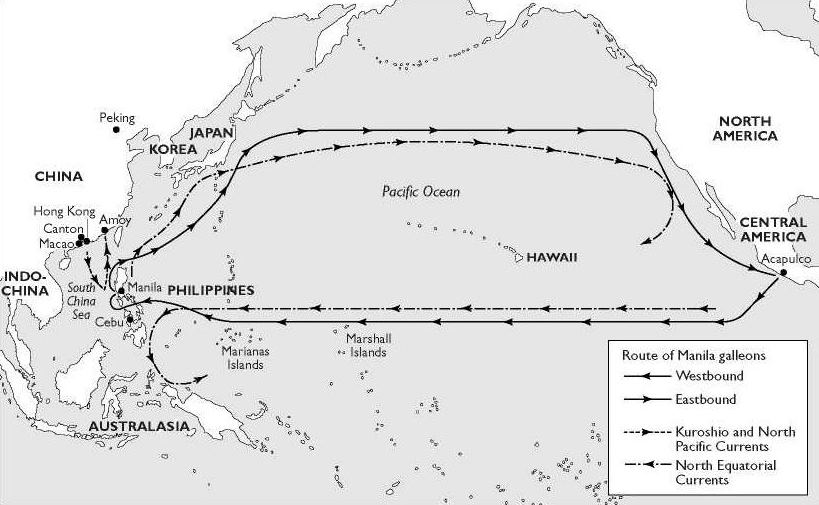
Manila Galleon Pacific Routes
The Galleons Sailed Close Along The California Coast
The viceroy had been informed of the pirates' activities and took steps to defend the Manila galleon. He ordered Admiral Isidro Atondo y Antillon ... [to] escort the ship expected from China. Atondo [with Kino] sailed from Matanchel on November 25 and crossed in only three days to Cape San Lucas, where the Manila galleon "Santa Rosa" had just arrived, an amazing coincidence. The two vessels crossed the mouth of the gulf, reaching ... Acapulco on the 20th. How they managed to avoid [pirates] Swan and Townley, whom they must have passed just south of Salagua, is a mystery. ... In Mexico the galleon's escape was considered a miracle.
Peter Gerhard
"Pirates on the West Coast of New Spain, 1575-1742" 1960
Much More About Kino and The Pirates
CORRESPONDING SUBJECT PAGE LINKS: To receive a full account of Kino’s work in California, click on the links below to the main corresponding subject pages. To view Kino’s explorations and the interesting account of Kino sailing along the Pacific Coast to Acapulco to protect a Manila Galleon from pirate attack, click Explorer Baja and Pacific Coast page. To view Kino's decade long advocacy after leaving Baja and his supplying its precarious restarted missions from the mainland, click California Builder page.

María Guadalupe de Lancaster
Duchess of Aveiro, Arcos y Maqueda with Her Children
Mother of the Missions 1692
Kino Asks the Duchess to Petition The King For Reduce Prison Sentences For The Pirates Imprisoned in Mexico City
Kino asks the Duchess of Aveiro, Arcos y Maqueda that she request that King of Spain reduce the prison sentences of 25 English pirates captured along the Pacific coast in the letter set out below. The letter was written on the day Kino left Mexico City to travel 1,500 miles to his new assignment in the Pimeria Alta. Kino ministered to the pirates in prison while he was waiting for eight months in Mexico City to learn of his new assignment.
"P.S. .... I commend to your Excellency the twenty-one Englishmen whom we recently converted here; I refer to this in the hope that there may be some opportunity offered you of securing a mitigation of their prison term which is five years. Do pardon the trouble which my requests may entail."
Kino's Letter To The Duchess
Upon Departing for the Pimeria Alta
Plan for Jesuit Return to California 1686
Eusebio Francisco Kino
Your Excellency, the Peace of Our Lord be with you!
Some six months ago, shortly after reaching Mexico City from California (or Carolinas), I wrote <2> to your Excellency giving you an account of that vast Island's extensive mission field so ripe for the harvest of souls, and the heartrending pleadings which those gentle and tractable natives (after their instruction in the tenets of our holy faith) are making to receive holy baptism. <3> I also recounted how we sailed out in the California ships to meet and warn the Manila Galleon about the enemy pirates lurking along the coasts of the South Sea in order to capture it. By God's favor, we succeeded in bringing the Galleon into the port of Acapulco to the chagrin of the four enemy ships. <4>
Afterwards, about the middle of January of this present year of 1686, we continued from Acapulco to Mexico City. In April, as we were on the point of returning to California to get on with the conversion of the many docile natives and gather in so ripe a harvest, a decree arrived from Madrid. Inasmuch as the previous year of 1685 a report had gone out from here to the effect that Nueva Vizcaya, <5> because of the natives' restiveness, was on the brink of ruin, the order came enjoining the assistance to and preservation of that province or territory of Nueva Vizcaya, even if this entailed the suspension of the California enterprise with its settlement and conversion. But as this suspension was effected not because of the peril to which Nueva Vizcaya is exposed (as the royal Attorney-general <6> states in his reply of May 6th of the present year of 1686), additional subsidies instead were obtained for four new missions: <7> two among the Tarahumaras and the others among the pagan Seri and Guayma Indians who live within sight of California, so close that only fifteen or sixteen leagues separate them. My superiors recently appointed me to found this new mission or missions among the Seris and Guaymas, who are also pleading for holy baptism. For this purpose I shall be departing, God willing, from Mexico City in just two days. <8>
Although we are hoping that the final decision for the continuing of the settlement and conversion of California (or Carolinas) will be a favorable one, and are consoled by the news that the next Viceroy <9> is well disposed towards the missions through his devotion to the eminent apostle and angelic Saint Francis Xavier, and, further, are reassured by the grant of two subsidies for the two new missions among the Seris and Guaymas with the observation that the sum would thus help promote the continuity of the conversion of nearby California; despite all this, the uncertainty of the future is blocking or delaying the dispatch of the spiritual assistance for the salvation of so many souls so eager to receive holy baptism. <10> In all sincerity and from the depth of my heart, as also in the name of those gentle and tractable natives, I commend, not once but a thousand times, this enterprise to the holy zeal of your Excellency so that, when the occasion presents itself and you judge it opportune, you will deign to favor so holy a cause. To this end it would help to keep in mind the following three points. <11>
The first is that at present it is possible to secure the continuation of the settlement and conversion of California with a moderate and wisely employed sum from the royal treasury, <12> whereas since 1680 nearly half a million pesos have been spent <13> (that is, approximately one hundred thousand pesos each year), and the earlier expeditions <14> entailed an outlay of two million more, namely those of Hernan Cortés in 1523, of Sebastian Vizcaino in 1597 and 1602, of Francisco Ortega in 1634, of Admiral Pedro Porter Casanate in 1644, of Bernardo Bernal de Piñadero in 1677 and other attempts involving large ships and "long boards," armed soldiers and marines, weapons, supplies and repairs; the expenditures for the discovery and settlement of California amounted to the sums stated above. But now with a couple of long boats and a small garrison of twenty or twenty-five soldiers and four to six missionaries (a total expenditure of some twenty thousand pesos and, if necessary, of even a smaller outlay), it is possible to effect the desired project of the peaceful settlement of California, as can testify many level-headed men with experience gathered during the last few years through their participation in the California enterprise.
Everyone knows how much the undertaking has suffered and has been retarded and how much useless expenditure has been incurred by employing large ships and sailing them over a route more than two hundred leagues from Compostela and Guadalajara in order to transport the provisions to California, with a delay of usually nine or ten months until the bulky shipment finally arrived and half rotten at that; whereas with a weekly crossing of long boats from Sinaloa and Yaqui, it would be easy to secure all that one might desire.
The second is that the settlement, enterprise and conversion of California has experienced many difficulties, obstacles and delays (purposely created, by the way). The enemy of mankind in the attainment of its salvation, furious that so great a prize, securely his for so many years, should slip from his grasp, associated with some others, has so resolutely opposed the Society of Jesus, that one may appositely say with the Apostle of the Gentiles in his First Epistle to the Corinthians, XVI, 9: "For a great door and evident is opened unto me; and many adversaries."
Despite the large number of the difficulties, <15> they can be reduced to these three: the first, the great expense; the second, the drought and unproductiveness of the land, so much so that some have not hesitated to say that the country is uninhabitable; the third, the diseases, especially scurvy, which during the past months of March, April and May of 1685 made victims of many soldiers.
The replies to these three difficulties are as follows. The solution to the first has been indicated above, namely in the first point discussed. The second difficulty states that the drought in California lasted a year and a half; it is at least extenuated by realizing that the drought was general; that is, almost everywhere in New Spain and North America, and that when we reached California on October 6, 1683, and proceeded to San Bruno, we found attractive and fertile lands with plentiful pastures for herds and suitable for planting, as Admiral Isidro de Atondo y Antillón wrote to the Viceroy in a letter dated October 15, 1683. The bit of maize and wheat and other grain which we then planted gave a yield equal to that of any part of New Spain; from the wheat harvested bread was made and the hosts with which for a long time the holy sacrifice of the Mass was celebrated.
Likewise, from the information furnished by the California natives, it is certain that farther north <16> there are lands which are level, rich and fertile, and with abundant water. There is a royal decree with the statement that on the 36th parallel there are trees to build ships of any tonnage. It is also certain that we have not yet seen one percent of California, which is so extensive that the distance from Cabo San Lucas <17> to Cabo Mendocino and Cabo Blanco is over five hundred leagues; <18> and, according to sea charts and the accounts of Sebastian Vizcaíno, Francisco Ortega, Pedro Porter de Casanate and others who on various occasions sailed over to California in order to explore the region (and their statements agree with what the natives have told us), all of California is inhabited by numerous tractable and peaceful Indians. And should there at times be any scarcity of some provisions in California, they could be imported by small craft from the productive nearby regions, namely from the lands of the Seris, Guaymas, Sinaloans and Yaquis. Thus, the necessary help and alleviation could be secured.
As for the third difficulty, namely that of the diseases which they experienced during the past months of March, April and May, the same prevailed to an equal degree and with a high mortality rate in various parts of New Spain. Now, if instead of living in Fort Bruno <19> whose water supply turns very salty because of its proximity to the sea, headquarters were set up in the other fort (San Isidro and San Nicolas, or Los Reyes) or on some other site further inland where even in time of drought the sources furnish an abundance of good water, all would live less subject to such diseases. The most efficacious remedy against such as break out on board ship is to secure fresh provisions, and these can easily be brought over in small craft, namely the so-called "long-boats."
The third point is this. It is now very easy to effect the settlement and conversion of California, at least in various region of the country, inasmuch as it lies only 25 leagues across the strait (in some places, only twenty, nineteen or sixteen leagues). This means a sea voyage of ordinarily twenty hours, and sometimes of only fifteen, twelve or even less. <20> We have secured very good ports on both sides of this calm and tranquil gulf.
We have learned two of the native languages <21> and have brought three California Indians to New Spain who already know Spanish well and can act as expert interpreters. <22> But what most facilitates the settlement and conversion is that the people of California are so gentle, submissive and peaceful that even after our men on various occasions had slain a total of thirteen of them, <23> we received no harm from them by way of vengeance, but rather always signal kindness and esteem and even a truly devoted affection, especially the missionaries of the Society of Jesus, whom they consider as heaven-sent teachers and often in times of drought were asked to pray for rain, etc.
It is true that during the last two years to the present, we have baptized only eleven natives, <24> and these were on the point of death. Of the eleven three recovered, and these unfortunately have stayed behind among the pagans. The fewness of baptisms was due to the withholding during the years of the authorization to confer the sacrament with solemnity. The officials here in Mexico City were supposed to send us the decision to continue the enterprise of settling and converting the region, but because this decision was so slow in reaching us over the tortuous route it followed, we proceeded to Matanchel, a port on the mainland of New Spain. <25> We were immediately dispatched to meet and warn the Philippine Galleon; thus property aboard the Manila Galleon worth some four million pesos escaped by heaven's favor the pirates' grasp.
And although I have written a book in Latin <26> called the New Carolinas, on all these themes relating to California, on the voyages and expeditions undertaken to date, on the inhabitants and their ways, on the other Jesuit missions and neighboring pagan tribes of North America, on the vast amounts of money in behalf of the welfare and eternal salvation of souls being spent by his Catholic Majesty (whom God protect) with so sacred intent and so generously, and Father Baltasar de Mansilla, <27> God willing, will take a copy of the book to Spain for publication if superiors approve, nonetheless in the meantime through this letter I come pleading on my knees in behalf of so many souls to the most pious zeal of your Excellency, and beg of you, by the most precious blood of our Creator and Redeemer Jesus Christ, that you deign to assist and help us, as occasion offers in Madrid, in order that the advantage of so ripe a harvest and the vast expenditures of his Catholic Majesty (whom God protect) and the price paid for by the most sacred passion and death of Our Lord be not lost.
My superiors here have promised me that, on the arrival of a favorable decision from Madrid regarding the conversion of California, they will send me to continue in its missions, and then I shall turn over to another the foundations which I have made among the Seris and Guaymas. In just two days I shall be leaving from Mexico City for those missions; <28> I have been provided with church bells, chalices and altar furnishings.
I repeatedly commend all to the fervent prayers of your Excellency, and ask Our Lord to keep your Excellency through the years in true happiness and increase of heaven-sent gifts, as I desire and these souls stand in need.
Mexico City, November 16, 1686.
Most devotedly yours,
Eusebio Francisco Kino
P.S. On the feast days of Saint Francis Xavier and of the Immaculate Conception of Our Lady, in accordance with my promise <29> I shall offer, God willing, my Masses for the intention of your Excellency and the spiritual and temporal welfare of my dear friends, Joaquin, Gabriel and Isabel. I commend to your Excellency the twenty-one Englishmen whom we recently converted here; I refer to this in the hope that there may be some opportunity offered you of securing a mitigation of their prison term which is five years. Do pardon the trouble which my requests may entail. <30>
Editor Note: The Duchess of Aveiro y Arcos, María Guadalupe de Lancaster, (1630 - 1715) was from a noble and wealthy Portuguese family. She was a great patron of charities and of the missions in all parts of the world especially Jesuit foreign mission. She was called "The Mother of The Missions." She was an accomplished linguist, patroness of letters and famous painter who my have been a pupil of Velasquez. She was a person of great influence in the courts in Madrid, Lisbon and Rome.
The Duchess and Kino began their correspondence during Kino's 2 year interlude in Spain while waiting to take ship to the New World. Their correspondence continued while Kino worked in New Spain. The Duchess and Kino never met in person. Kino's letters to the Duchess totaling over 30 give great insight into Kino's hopes and ideas. Most of Kino's original letters the now exist are owned by the Huntington Library.
San Bruno Mission Site, Baja California
"What They Had Accomplished"
Herbert E. Bolton
There is a type of historian who might call the Atondo-Kino episode in California a failure. But what is failure? Often it is growth in wisdom. Civilization goes forward by a process of trial and error. We tend to profit by experience, and in proportion as we do this all experience may be regarded as gain. Baja California was a difficult region, as nearly devoid of means for sustaining civilization as almost any place in the world. Various attempts had been made to occupy the barren Peninsula. None had accomplished the specific thing intended, but each had made its contribution. Atondo and Kino by hard experience acquired an intimate acquaintance with two regions, La Paz and San Bruno, and explored two other important districts, the River of Santo Tomás and the Bay of San Dionisio. If these two pioneers had returned, the occupation of the latter was to be the next step.
They did not return, but their experience was utilized to advantage by their successors. When Salvatierra took up the work of Christianizing Baja California twelve years later, he began exactly where Kino left off. San Dionisio became his capital and the valley of San Bruno was reoccupied at San Isidro. The River of Santo Tomás, renamed La Purísima, became one of the important mission districts under Salvatierra and his associates. Kino while on the Peninsula compiled a vocabulary and arte or grammar of the Güimí (Cuchimí) language, spoken by the natives at San 'Bruno. Copart wrote a Catechism in the Edu or Monquí tongue, which Salvatierra used when he began his great work at Loreto. Kino, Copart, Goñi and the Admiral had shown the way.
Atondo's experience demonstrated that a large Spanish colony could not exist in sterile Baja California, under methods then known, with out too great a drain on the royal treasury. The hope that colonization and missionary work might go hand in hand was abandoned as a consequence of Atondo's example, and the Peninsula was turned over to the Jesuits to be Christianized, with Spanish colonization left out of the scheme. Kino's proposal for a smaller garrison and smaller vessels was tried out by Salvatierra and proved to be sound. Kino suggested that for the support of the California missions, agricultural bases might be established on the mainland. Thus far the Yaqui missions had served this purpose. In keeping with this idea, Guaymas was founded by Salvatierra as a granary and stock ranch as well as a port for California.
In short, the work of Atondo and Kino was a success, in so far as it pointed the way to a better plan. Moreover, Kino was a distinct personal link between his period and the next. He never lost interest in the people whom he had left behind at San Bruno; he kept alive the project for re-establishing the California missions; and it was directly and personally from him that Salvatierra got his inspiration for his remarkable achievement. Finally, California had been for Kino himself a school of experience which prepared him to accomplish similarly remarkable things.
Secondary and unlocked-for results of human enterprise after: outweigh those at the time regarded as primary. It was so in this case. Few if any missionary episodes are better illuminated by contemporary records than this one whose scenes were La Paz and San Bruno. Atondo and Kino were the first to cross the Peninsula. The diaries, maps, linguistic notes, and letters of Kino, Copart, Atondo, Guzman, and others connected with the enterprise constitute a definite contribution to North American exploration, cartography, ethnology, and history, comparable, we might say, with the famous reports of Fremont, or of Lewis and Clark.
The Atondo expedition cost in the neighborhood of a quarter of a million of pesos. This was a large sum. But more than one scientific expedition, fitted out in recent times at greater expense, has accomplished much less even for pure science than Kino and Atondo achieved and recorded.
Herbert E. Bolton
Chapter 63 "What They Had Accomplished"
"Rim of Christendom - A Biography of Eusebio Francisco Kino: Pacific Coast Pioneer"
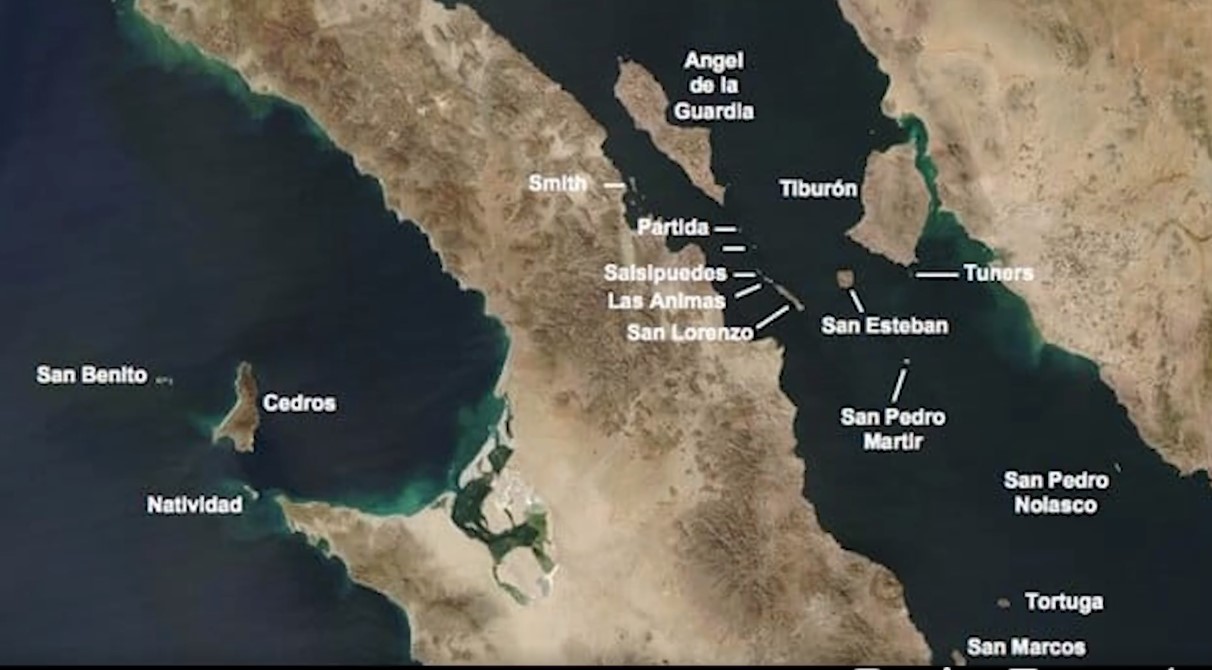
Kino Plan Of Using Gulf Islands as Stepping Stones To Return To California
Island Stepping Stone Return Plan
"Kino en California: 1681-1686"
Gabriel Gómez Padilla
Gabriel Gómez Padilla
"Kino en California: 1681-1686"
Espiral (Guadalajara), 21(61), 145-190. 2014
Spanish
Click →
http://www.scielo.org.mx/scielo.php?script=sci_arttext&pid=S1665-05652014000300006&lng=es&tlng=es.
Resumen
En este artículo se plantea un doble propósito: exponer la participación del jesuita en la expedición de Isidro Atondo y Antillón a la Baja California y rendir tributo académico a la memoria de Miguel Mathes por su labor documental sobre Eusebio Francisco Kino. Se tratan los intentos de la Corona española por colonizar California y también se ofrece una breve biografía de Atondo para contextuar los documentos usados, los cuales van desde las capitulaciones de Atondo hasta la implementación del proyecto seri, ideado por Kino para luchar por el derecho de los californios a ser evangelizados.
For quick English translation using either
Google and Microsoft translation programs
Find and Click on "Traducción Automática" link in the right menu.
Abstract
The article by Gabriel Gómez Padilla has discusses the participation of the Jesuits in the Atondo and Antillón Expedition to Baja California and pays tribute to the memory of Dr. Miguel W. Mathes (1936-2012) who was the leading U.S.scholar on the history Baja California. Dr. Matthes was the key researcher the documentation of Kino's work in the Baja missions.
The article also discusses the previous attempts of the Spanish Crown to colonize California and contains a brief biography of Isidro Atondo and Antillón. The documents range from Atondo's agreements with the Spanish Crown at the beginning to the end of the effort with Kino's "Seri project" - Kino's first plan for return of the Jesuits to Baja [using Gulf islands as stepping stones].
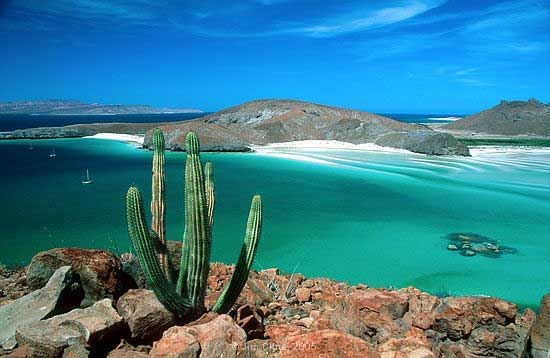
The Coast of La Paz
Kino Named His First Mission in Honor of Our Lady of Guadalupe
"Padre Kino and the Trail to the Pacific"
Jack Steffan
For an acccurate historical fiction account based on Kino's writings about Kino's missionary work in the Baja California
Click
Chapter 1 - California Mission document (text)
Kino Continues To Advocate For California Return
On His Journey to Work In Sonora 1686
The missionaries [from California] were appointed by their superiors to other Missions. Father Kino went to Sonora, the theater of his fervid zeal, whence he hoped to go to California. With this thought he left Mexico [City] on October 20, 1686, and on passing through the provinces of Tepehuana and Sinaloa he inflamed the spirits of the Jesuit missionaries there in favor of the conversion of the poor and forsaken Californians. One of the many who felt inspired for such an enterprise by the ardent words of Father Kino was Father Juan María de Salvatierra ...
Francesco Javier Clavigero, S.J.
Historia de la Antigua o Baja California , 1789
English translation from
Chapter 8: The Zeal Of Some Jesuits For The Conversion Of California And Its SuccessThe History of Lower California, 1937
Kino's Contributions to World History
Carlos Lazcano Sahagún
Sin Kino la fundación de la Antigua California difícilmente se hubiera llevado a cabo, por lo que el avance hacia la Nueva California habría sido imposible, quedando toda la costa del noroeste de América a merced de la penetración de los rusos y los ingleses, situación Kino advirtió en varias ocasiones. Es decir, sin Kino la península de California difícilmente sería mexicana.
English Translation: Without Kino, the founding of Antigua California [now Mexico] would probably not have been carried out, so the advance towards New California [now United States] would have been impossible, leaving the entire northwest coast of America at the mercy of penetration by the Russians and the English, a situation, Kino warned about on several occasions. That is to say, without Kino the California peninsula would probably not be Mexican.
Carlos Lazcano Sahagún
La California de Kino: Orígen y destino. 1683-1711" 2024
New Monumental Kino Books

Kino en California
Textos, Cartografías y Testimonios 1683-1711
"Kino en California Textos, Cartografías y Testimonios 1683-1711"
Carlos Lazcano Sahagún
Gabriel Gómez Padilla (2021) (1,350 pages)
"La California de Kino: Orígen y destino. 1683-1711"
Carlos Lazcano Sahagún (2021) (319 pages)
Monumental scholarship about Kino's key role as the leader and driving force in the permanent settlement of The Californias by the Spanish.
CORRESPONDING SUBJECT PAGE LINKS: To receive a full account of Kino’s work in California, click on the links below to the main corresponding subject pages. To view Kino’s explorations and the interesting account of Kino sailing along the Pacific Coast to Acapulco to protect a Manila Galleon from pirate attack, click Explorer Baja and Pacific Coast page. To view Kino's decade long advocacy after leaving Baja and his supplying its precarious restarted missions from the mainland, click California Builder page.
